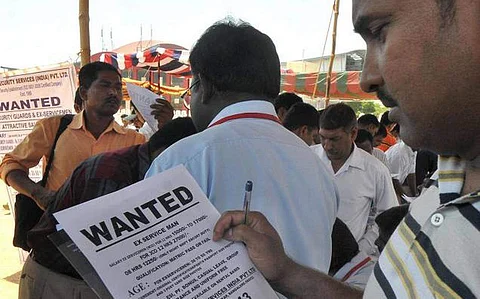

At a time when over 5.5 million jobs have been lost because of the pandemic, this initiative by two academics and an entrepreneur could end up creating 56 million new jobs.
The Coronavirus pandemic has highlighted how important it is for India to have urban employment generation schemes. The informal workers had suffered the most and so did the micro and nano entrepreneurs. Serial entrepreneur and founder of the TMI Group, T Muralidharan, Dr Bino Paul from the Tata Institute of Social Sciences, Mumbai (TISS) and Dr Amit Basole from Azim Premji University's School of Arts and Sciences have come up with a model to address the unemployment problem that India is suffering from.
Emphasising the need to help and scale up the existing micro-entrepreneurs the researchers proposed setting up a network for assisting them with the process — Udyog Sahayak Enterprises Network (USENET). The USENET will have a two-pronged approach — it will not only help build a network for more than 100 million micro-entrepreneurs, but it will also provide jobs for the educated youth as employees of the network. It proposes to create 56 million new jobs and impact more than 80 million MSEs.
What is USENET?
It is a support system which will make the MSEs go digital, grow in scale and increase their productivity. "Instead of encouraging more micro or nano start-ups, we should focus on the existing one. The idea is to find an enabling environment for them. We build a support system for them to go digital, let them know about government schemes, grow in scale, increase their productivity. The network itself is a micro set up. This is the time for it as India and the world is going online," said Dr Basole. "The model has taken inspiration from the common service centres and anganwadis. The Udyog Sahayaks will be educated youth who will handle 15 to 50 micro firms. This will ensure employment on both sides of the spectrum," he added.
The plan proposes that a total of 18 lakh Udyog Sahayak Enterprises (USEs) should be created over a span of five years as part of the USENET project — 5 lakh in Year 1, 6 lakh more by Year 3 and 7 lakh more by Year 5 — with the aim of scaling up these MSEs and also improving the Ease of Doing Business (EDB) for millions of MSEs. "Till date, the EDB was focussed on the large and medium enterprises. It is important to take EDB to the most important segment of the Indian Economy – MSEs," read the report.
What will the USENET help the MSEs with?
USENET will be a "complete entrepreneurship model", with the Government of India "catalysing the enablement of the factors that would lead to self-sustenance of the USEs". the researchers have imagined it as a service or transaction-oriented model with a plethora of services which would be made available to the MSEs at their doorstep — digitisation and formalisation, availing government loans, subsidies or other benefits, ensuring compliance with local, regional, and national regulation, aiding partnership with digital marketing platforms and digital payment platforms, etc.
"Each USENET (employee) will be allotted 15 MSEs initially to work with on a continuing basis and build a trust relationship with them. Every year thereafter a few more will be added till each USE will reach a capacity of 50 MSEs that they have a relationship with. Total reach through the 18 lakh USE network will be 4.4 crore MSEs in 5 years and will reach 8.1 crore MSEs in 10 years (Current 6.2 crore MSEs can grow to 8 crores in ten years due to the aggressive policies of GoI)," the researchers explained.
Why concentrate on MSEs?
Not only are they a huge community which is informal and scattered they also employ a huge chink of workers. As for political incentive — they form a significant part of the vote bank. "We must put the micro-entrepreneurs at the centre of the Indian economy. They are a larger community then the farmers and they probably have to work harder than the farmers too," said Muralidharan. India has been suffering from a very low elasticity of employment with respect to output for years now — the percentage increase in employment for every 1 per cent increase in GDP (output) is very low or in some cases even decreasing. "By enabling scale-up, USENET will increase employment elasticity in the MSME sector. We estimate that an additional 1 crore (10.3 million) jobs can be created over five years going up to nearly 6 crores (56.9 million) over 10 years," added Muralidharan.
After six years, the plan proposes, the Government financial support can be withdrawn and the USEs will operate on its own. "At the end of the first five years, the income of the Udyog Sahayak entrepreneur is expected to be Rs. 1,33,000 per year. Lessons from CSC (village level entrepreneur), BC and Anganwadi models indicate that a sustainable flow of income of at least Rs 12,000 per month is key to the success of the model," read the report.
Women to the front?
USENET will also potentially benefit women entrepreneurs and enhance female labour force participation, said Dr Basole. "USENET training can mandate at least 35 per cent participation from women going up to 50 per cent by Year 3 of USENET training. Management of the Udyog Sahayak Enterprise can have an equal gender balance and give first priority to assisting women-led enterprises. USE will have a specific focus on encouraging enterprises that help reduce the gender barriers to active female labour force participation – such as connecting women entrepreneurs with child care centres, safer transportation practices that facilitate greater women mobility, working with public safety officials to ensure a safe environment for women to work outside the home," he explained in the report.
